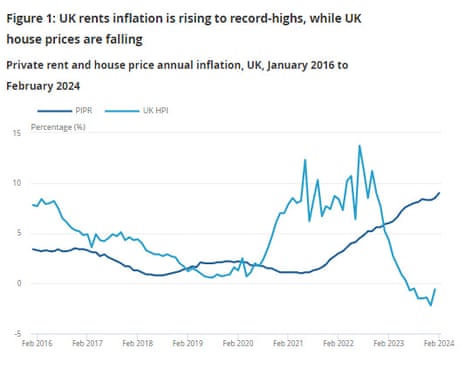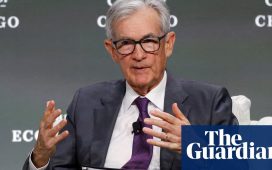Full story: UK inflation falls to 3.4% in February to lowest level for two and a half years

Phillip Inman
UK inflation fell to 3.4% in February – the lowest level for two and a half years – according to official figures that show the annual rate of price rises starting to ease again after remaining unchanged the previous month.
The decline in the consumer prices index (CPI) from 4% in January will give a boost to Rishi Sunak, who has pledged to reduce inflation, and add to speculation that the Bank of England will cut interest rates in the summer.
Most economists had predicted that February’s headline figure from the Office for National Statistics (ONS) would drop to 3.5% – the lowest since September 2021, when it was 3.1%. A reduction in the rate of inflation does not mean that prices are falling, just that they are rising more slowly.
Investors are betting that inflation will tumble further through the spring months, reflecting the sharp decline in the price of natural gas since last year and a slowdown in food price rises.
Key events
Intel wins nearly $20bn from Biden administration to boost US chip output
In the technology sector, chip giant Intel has secured nearly $20bn in grants and loans from the US government.
It’s the Biden administration’s largest outlay so far to subsidize leading-edge chip production, as the White House tries to strengthen its domestic semiconductor production.
President Biden is expected to annouce that Intel will receive $8.5bn in grants and up to $11bn in loans when he visits Arizona today.
Some of the funding to be used to build two new factories and modernize an existing one, Reuters reports.
US Secretary of Commerce Gina Raimondo told reporters this is “a huge deal”, Fortune reports, adding:
“It means bleeding-edge semiconductors made in the USA, keeping the USA in the driver’s seat of innovation.”
Greggs stores in cities including London, Manchester, Cardiff and Glasgow have reportedly been hit by the technical issues preventing them from accepting payments, PA Media reports.
Others asked customers to place orders outside using the Greggs mobile app before food could be given to them, they add.
UK rents climb by fastest rate since at least 2015
Newsflash: UK tenants have been hit by soaring rents this year.
The average UK private rent increased by 9.0% in the 12 months to February, new data from the Office for National Statistics shows.
That’s up from 8.5% in January 2024, and is the highest rate since the data series began in January 2015.
The ONS says private rent inflation was highest in London ( at 10.6%) and lowest in the North East (at 5.7%).
Across the country, average monthly rents increased to £1,276 (up 8.8%) in England in the 12 months to February, to £723 (9.0%) in Wales and £944 (10.9%) in Scotland.
The average private rent was highest in Kensington and Chelsea (£3,248) and lowest in Dumfries and Galloway (£472).
The ONS also reports that average UK house prices fell by 0.6% in the 12 months to January 2024, to £282,000, up from a 2.2% drop in the year to December.

Another report of tech problems at Greggs today:
Greggs in Westminster closed. Problem with tills. Is this Nationwide or just local?
— GET TORIES DONE – GENERAL ELECTION NOW! (@snb19692) March 20, 2024
Greggs stores hit by IT problem
Newsflash: Bakery chain Greggs has become the latest UK chain to be hit by IT problems.
Several Greggs customers have reported problems making payments this morning, or that their local store is closed.
Greggs this morning cash only ! Sitting here with my coffee watching almost everyone have to walk out 😂
— Refusenik Paul (@geezerpaulr) March 20, 2024
Greggs says it is “experiencing issues accepting payments”, Sky News says.
In a statement, the bakery chain added:
“We are working to resolve this as soon as possible.”
Last week, McDonald’s restaurants in multiple countries including the UK and Australia were hit by a “technology outage”.
And both Sainsbury’s and Tesco experienced technical issues that disrupted supermarket deliveries last week.
The pound has slipped against the US dollar this morning, after inflation fell faster than expected.
Sterling is down 0.2% at just below $1.27, which would be its lowest closing level in two weeks.
The Bank of England isn’t expected to cut interest rates as soon as this month, though.
It will announce its latest decision at noon on Thursday, and the money markets indicate there’s a 97% chance that the BoE leaves rates on hold at 5.25%.
Annual CPI #inflation was 3.4 per cent in February, falling from 4.0 per cent in January, driven by downward contributions from food and alcoholic beverages. This figure represents the lowest annual CPI inflation figure since September 2021 and possibly signals that the #MPC can…
— National Institute of Economic and Social Research (@NIESRorg) March 20, 2024
NIESR’s trimmed-mean inflation measure (which excludes 5 per cent of the highest and lowest price changes to eliminate volatility) at 3.9 per cent. As a result, we expect the BoE to keep #InterestRates unchanged in the upcoming MPC meeting this week.
7/7 ENDS
Watch this page… pic.twitter.com/SPAUrAag9o
— National Institute of Economic and Social Research (@NIESRorg) March 20, 2024
The UK’s “disinflationary tailwind” should allow the Bank of England to cut interest rates this year, explains Charles Hepworth, investment director at GAM Investments:
“Consumer inflation in the UK continues its slow descent towards the 2% base camp, recording a slightly quicker than expected fall to 3.4% in February from the 4% level in January.
Coupled with goods inflation slowing we also saw producer price input inflation fall more than expected, declining 0.4% over the month. This should help translate into additional inflation slowing effects in the months ahead. This disinflationary tailwind will encourage market expectations of rate cuts coming this summer and market forecasts expect three 0.25% cuts for the year in total. This is likely the best a government pushing for an autumn election could hope for.”
Explaining February’s drop in inflation, ONS Chief Economist Grant Fitzner says:
“Inflation eased in February to its lowest rate for nearly two and half years.
“Food prices were the main driver of the fall, with prices almost unchanged this year compared with a large rise last year, while restaurant and café price rises also slowed.
“These falls were only partially offset by price rises at the pump and a further increase in rental costs.”
Another encouraging sign for inflation is that UK factories paid less for their raw materials last month.
The latest producer price inflation report, also released this morning, showed that factory input prices fell by 0.4% on a monthly basis in February – a sign that inflationary pressures eased.
But producers still raised their prices, with output prices rising by 0.3% in February.
The ONS adds:
-
Producer input prices fell by 2.7% in the year to February 2024, up from a revised fall of 2.8% in the year to January 2024.
-
Producer output (factory gate) prices rose by 0.4% in the year to February 2024, up from a revised fall of 0.3% in the year to January 2024.
In the year to February 2024:
▪️ the cost of raw materials fell by 2.7%, up from a revised fall of 2.8% in January
▪️ the cost of goods leaving factories rose by 0.4%, up from a revised fall of 0.3%
— Office for National Statistics (ONS) (@ONS) March 20, 2024
Resolution: Fastest inflation fall in nearly half a century puts 2% target in sight
The fastest inflation fall in nearly half a century suggests UK is on track to hit two per cent target by April, says the Resolution Foundation.
They say the Bank of England will be encouraged that services inflation fell to 6.1% in February, as that is a gauge of domestic inflation.
James Smith, research director at the Resolution Foundation, says:
“The fastest fall in inflation for almost half a century will be welcome news for households – with food inflation falling to its lowest rate in two years – and the Bank of England, as inflation looks on track to hit its 2 per cent target in April.”
“Services inflation also continues to fall which, coupled with falling nominal wage growth, should give monetary policy makers more confidence that wage pressures on inflation are starting to ease.”
Update: this is based on the 7 percentage point fall in the CPI over the last 12 months – from 10.4% in February 2023 to 3.4% last monthe – the largest 12-month period since September 1978.
Table: CPI annual and monthly inflation rates by division
Digging into today’s CPI report, we can see that food and non-alcoholic beverage inflation slowed sharply last month, to 5% from 6.9%.
Alcohol and tobacco prices rose at a slower pace too, bringing their annual inflation rate down to 11.9% from 12.4%.
A smaller monthly rise in prices meant that Clothing and footwear inflation eased to 5% from 5.6% in January, while furnutire nad household goods prices were flat year-on-year.
This table has more details:
EY ITEM Club: inflation could fall below 2% target next month
February’s sharp fall in inflation was largely due to base effects, following large rises in food and services prices between January and February last year.
Those base effects, and the drop in energy bills this year, means inflation could fall below the Bank of England’s 2% target soon.
Martin Beck, chief economic advisor to the EY ITEM Club, explains:
“Base effects will remain influential over the next couple of months and, along with a 12% fall in Ofgem’s energy price cap, this should mean inflation falls to, or below, the Bank of England’s 2% target in April.
Furthermore, although only a month of Ofgem’s new observation window has passed, lower wholesale gas prices point to another substantial fall in the energy price cap and household bills in July. So, there’s a good chance that inflation declines well below 2% in the second half of the year.
The financial markets are still expecting the Bank of England to cut interest rates three times this year, starting in the summer.
That would bring rates down to 4.5% by December, from 5.25% today.
Victoria Scholar, Head of Investment at interactive investor, tells us:
Inflation is certainly moving in the right direction, quicker than expected and is forecast to reach the 2% target in the months ahead. Global factors such as easing global supply chain pressures and cooling energy prices combined with higher interest rates from the Bank of England have helped price pressures retreat from a 40-year high seen in October 2022.
Markets are pricing in a longer wait for the first rate cut from the Bank of England than other central banks such as the US Federal Reserve with growing positive bets on the pound from hedge funds and traders reflecting this view.
UK rate futures markets are pointing to 71 basis points of rate cuts from the Bank of England by December, up very modestly from 67 basis points before today’s inflation data. Most economists anticipate the central bank will begin cutting in June.”
Today’s inflation report does not reflect the full impact of the cost of living squeeze,
Dr Sarah Cumbers, chief executive of the Royal Statistical Society, explains:
“While it’s good to see inflation coming down, we should remember that CPI was never intended to measure the impact of inflation on households.
“Its exclusion of interest payments such as mortgages and loans – and the greater weight it gives to higher spending households – means people’s experiences of inflation, particularly those on lower incomes, are not adequately reflected in the figures.
“I would encourage policymakers to take into account the Household Costs Indices, now published quarterly by ONS as the best way to understand the impact of inflation on different groups.”
The most recent Household Costs Indices, released last month, showed that households with a mortage had the highest inflation rate at the end of last year, followed by private renters, with outright owner occupiers experiencing the lowest rate.
Annual motor fuel inflation is negative for twelfth consecutive month
Today’s inflation report confirms that motor fuel prices picked up in February, but was still cheaper than a year ago (when energy costs were much higher).
The average price of petrol rose by 2.3p per litre between January and February to 142.2p per litre, down from 148p per litre in February 2023, the ONS says.
Diesel prices rose by 3p per litre in February to 151.3p per litre, down from 169.5p in February 2023.
So overall, motor fuel prices fell by 6.5% in the year to February 2024, compared with a fall of 9.2% in the year to January.








